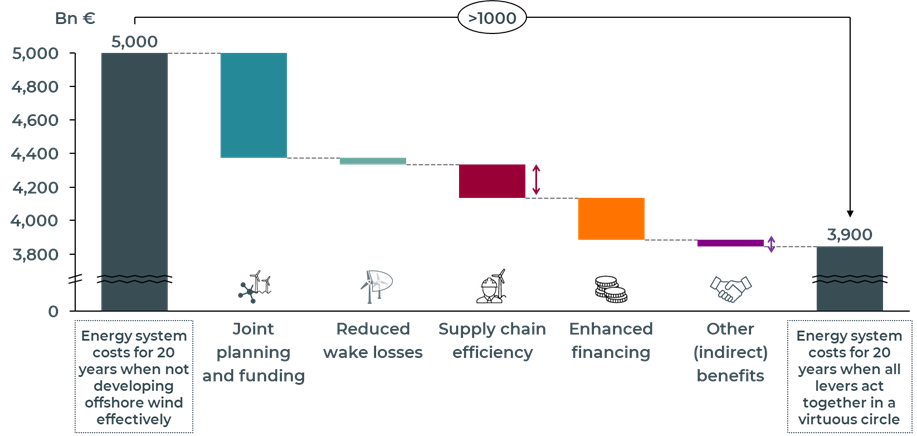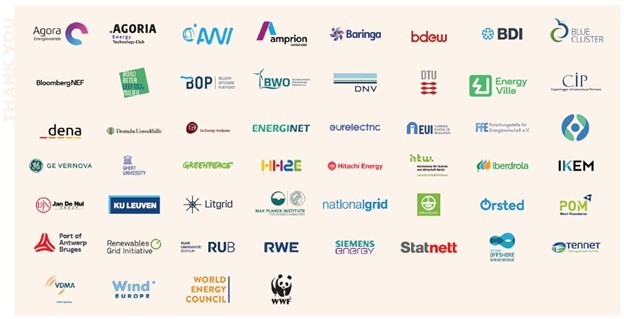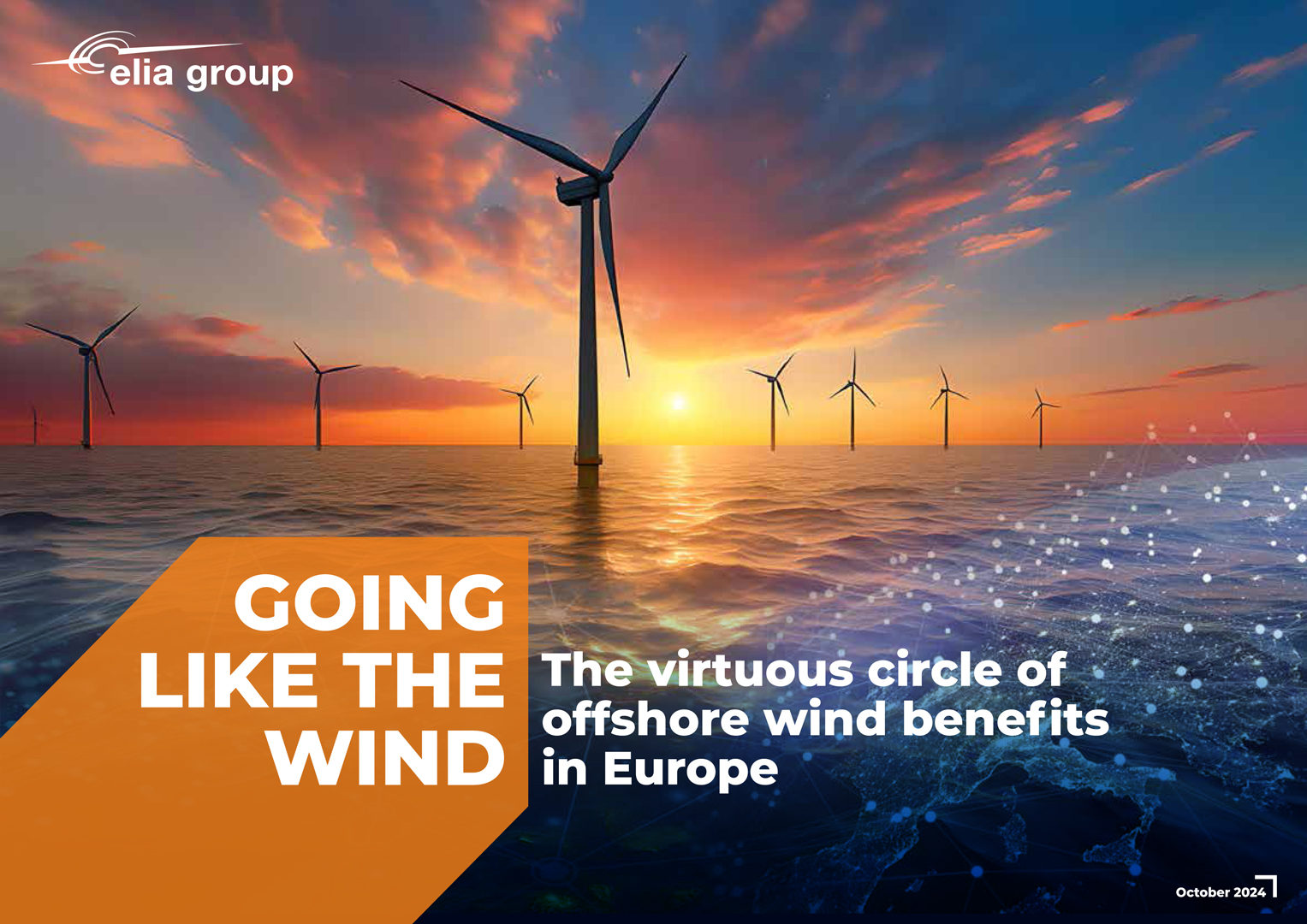15 October 2024
Elia Group launches vision paper on the virtuous circle of offshore wind benefits in Europe
- From 2030 to 2050, international collaboration, the de-risking of investments and spatial planning in offshore wind development could lower the cost of the energy transition in Europe by more than 1,000 billion euros.
- Adopting a coordinated approach to sea-basin-wide planning is required for Europe to tap into the most efficient offshore wind locations and harness almost 500 GW of offshore wind energy by 2050.
- A joint framework to fund future offshore development will be crucial for unlocking the benefits of sea-basin-wide planning.
- Scaling up the supply chain and securing raw material imports will offer up substantial growth opportunities along with the creation of 300,000 jobs across Europe.
Elia Group’s newest publication ‘Going Like the Wind’ explores how to unlock the clean energy potential held by Europe’s seas. Given the threat of climate change, the rising demand for electricity, and concerns about Europe’s energy independence, offshore wind is becoming increasingly prominent in discussions about the continent’s future energy mix. However, a range of challenges currently stands in the way of the development of offshore wind power. The study therefore explores the virtuous circle of offshore wind benefits in Europe. It demonstrates how international collaboration, strategic cross-border planning, investment security and the scaling up of supply chains in offshore wind development will each deliver benefits on their own and will also feed into each other’s success.
The next decade will be critical for empowering clean competitiveness in Europe
‘Going Like the Wind’ is one of the few studies that provides European actors with a more holistic view of the steps that need to be taken to bridge the gap between Europe’s current offshore wind capacity and its offshore capacity targets. These steps are essential, since, given that Europe’s offshore wind potential is not evenly spread out across different Member States, national solutions alone will not be enough to ensure the success of the energy transition.
Mario Draghi’s most recent report, ‘The Future of European Competitiveness’, has made clear what is currently at stake for Europe. It highlights the high cost of energy as being a significant barrier to the competitiveness of European businesses. The Draghi report emphasises that accelerating the decarbonisation of the energy system in a cost-effective manner is essential for sustainably lowering energy prices in the long term. The Draghi report also carries a very hopeful message. Indeed, the EU is a global front-runner in clean technology, with one fifth of clean technologies worldwide being developed on the continent. The global decarbonisation drive will offer up an opportunity for EU industry to grow.
Decarbonisation can become a significant source of economic growth
To ensure that the benefits of offshore wind in Europe create a virtuous circle, many challenges need to be addressed. Unlocking the potential of clean energy at sea demands immediate political action regarding joint planning and funding and concrete laws for the manufacturing industry to scale up and deliver on Europe’s ambitions. These concrete actions all rely on the timely development of an integrated grid.
“We have to step away from the 50-50 approach that has been adopted for the sharing out of costs and benefits associated with interconnectors. We urge the new European Commission to take prompt action and adopt a new approach to the distribution of costs and benefits that better reflects actual electricity flows. Moreover, maintaining the current status quo would not only put clean competitiveness at risk, it would also mean missing out on significant efficiency savings. The analysis for this study calculated the potential outcome of fully unlocking the benefits of international collaboration, the de-risking of investments, and an effective approach to offshore spatial planning. From 2030 to 2050, this could produce savings for the European energy system that amount to more than €1,000 billion”.
Catherine Vandenborre, Elia Group’s interim CEO
Benefits of collaboration
Reduction in system costs (€ bn) for the period 2030-2050 in Europe

The image above outlines how the large-scale development of offshore wind in Europe will be challenging and will be accompanied by a hefty price tag. However, it will also be accompanied by a warranty tag: improved security of supply, enhanced market liquidity thanks to more interconnectors, and ultimately local value creation across all the countries involved.
The chart therefore tells us that we should not focus on individual pain points; instead, we should focus on the big picture. We need a holistic approach to offshore development that covers whole sea basins at a time – one which involves a joint approach to the planning and funding of projects. We need this now so that the intended effects will be harvested in time. Most decisions and investment plans still need to be resolved, which opens up a window of opportunity right now. We can design the optimal governance structures today that are needed to put in motion the most impactful levers for the future.
Once each of these benefits has been successfully achieved, they will form a virtuous circle, reinforcing each other and contributing to indirect benefits such as Europe’s overall resilience to external shocks to its energy system.
The annual demand for offshore assets in Europe is going to double
To date, the market for onshore and offshore wind energy development has largely been a European one. Europe has demonstrated strong technological leadership through its manufacturing of assets and has played a leading role in innovative methods for connecting countries and offshore wind farms together.
The table below compares the current manufacturing capacities for three types of assets in Europe with their projected annual levels of demand between 2030 and 2050. The numbers show that the production capacities for all three asset types must be significantly increased to satisfy all of Europe’s needs via domestic suppliers only.
Meeting the future demand for assets and services has the potential to generate the creation of 300,000 jobs across the value chain.

“We have a clear vision and Europe has substantial legislation in place regarding this goal. However, what we currently lack is a strong incentive for ramping up the supply chain. There is a pressing need for Europe to create a framework that encourages increased investment, enabling us to remain technical leaders in offshore wind. I believe we have the potential to establish several 'Silicon Valleys' across Europe that focus on offshore wind. Imagine dedicated hubs for turbines, cables, platforms, and vessels, amongst other asset components. What a great opportunity that would be for innovation and job creation across the European continent.”
Catherine Vandenborre, Elia Group’s interim CEO
In preparation for our study, we engaged with many stakeholders from the European energy sector, including other transmission system operators, wind developers, industrial players from the supply chain, various federations, and academics. We would like to sincerely thank the stakeholders below for their valuable input and feedback.

The full report can be found on our website.

Livestreamed event hosted by Elia Group
Press releases
-
Elia Group launches vision paper on the virtuous circle of offshore wind benefits in EuropePDF - 589.57 KB
-
Elia Group lance une note de vision sur le cercle vertueux des avantages de l’éolien offshore en EuropePDF - 614.5 KB
-
Elia Group publiceert visienota over de meerwaarde van offshore wind voor het Europese elektriciteitssysteemPDF - 582.96 KB



